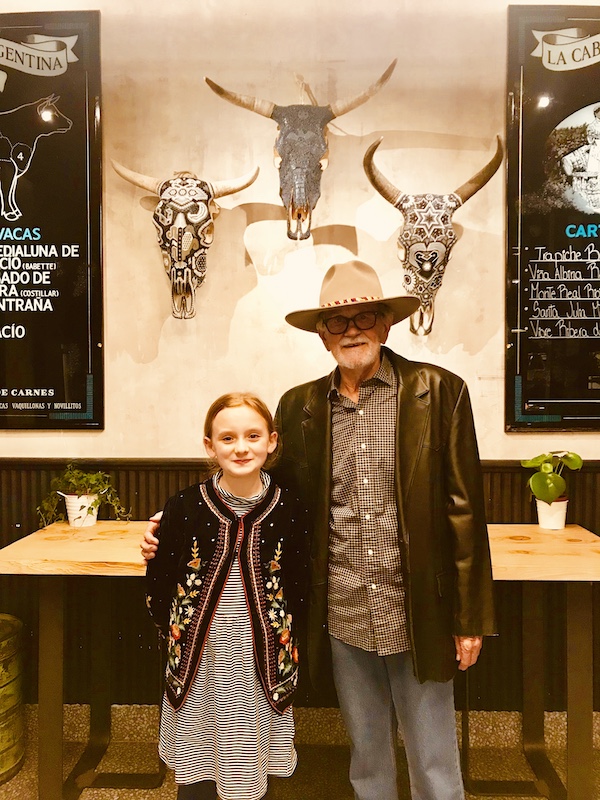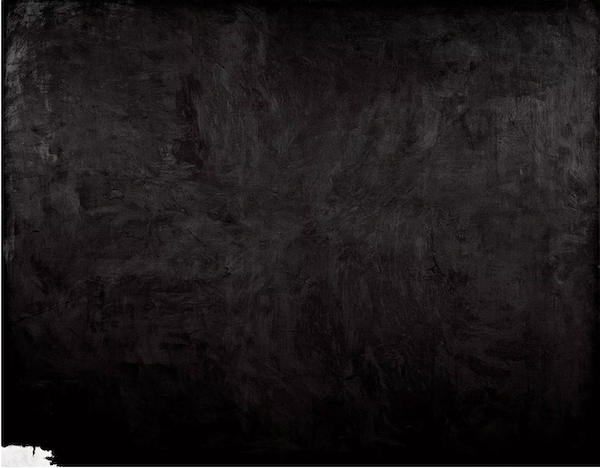I had wanted to see the Guggenheim Bilbao since it first opened. Ed Moses and I had once met up, completely by accident, in London. He had flown in from San Francisco and I from Los Angeles, arriving within the same hour. Ed invited me to stay with him, saying he had plenty of room. That night we joined Allen Jones at The Bohemian Club for dinner. Amazing fun. Ed and I had both come for a specific reason, both wishing to see something special: either the Pollock show again or maybe Chris Burden’s Toy Air Plane Making Machine. From London, Ed flew on to meet Frank Gehry in Madrid, then on to Bilbao. I flew to Milan and took the train to Venice, to meet Chris Burden and Nancy Rubens.
Now, after 20 years, I was going to Bilbao with Eloise, my 11-year-old daughter. We were so excited and arrived on Holy Saturday, with an 11 a.m. admission for Easter Sunday (a pleasant surprise to find they were open). We had a lovely breakfast in the rooftop restaurant, then headed downstairs and across the street to the Bilbao— smack-dab into Jeff Koons’ giant flower dog, Puppy; the first of many opportunities to shoot selfies.

James Hayward & Eloise.
From Koons’ Puppy, one walks down a long, wide gentle-on-the-knees flight of stairs, arriving at the large glass entrance. Tickets in hand, we enter and take the elevator to the top floor (open to the public). There is a Giorgio Morandi show being installed. It was rather small (I had seen a huge one in New York and a far better one in Winterthur, Switzerland) with nothing whatsoever that might be described as “Spectacular.” I had seen far better examples at Ed Finnegan’s studio in New York City.
The other show was Jenny Holzer, whose work I had loved, way back in the mid-’70s. Her early work was idealistic, succinct, simple and frugal in its methodology and had real bite, nipping away at heels of the art-world establishment. Here, the new works seemed reduced to flashing, kinetic jingles for the simpleminded, sliding blindly up the corporate ladder/walls. I am endlessly amazed at how many terrific artists end up being defanged by their own fame.

Jenny Holtzer at Guggenheim Museum Bilbao, 2019.
The permanent collection was no more interesting. They had the names but not the goodies. Start with perhaps the most visually appalling Rothko I have ever seen. The de Kooning was weak, as was most of the painting; predictable and uninspiring. Eloise liked the Yves Klein. My favorite was Motherwell’s, Iberia.

Robert Motherwell, Iberia, 1958.
The star works of art at the Bilbao are the unbelievable collection of Richard Serra’s massive curved steel pieces; easily the most I had ever seen in one place. Unfortunately, they are lined up in a long narrow room, forcing one into “intimate” viewings, never allowing one to see more than two parts of the dozen or more pieces present. Why this amazing collection of truly masterful sculptures is not displayed on one large plaza outside so the whole of it might be seen at once, is totally beyond me. As presented they are reminiscent of an eagle in a canary cage. I think this might just be the worst installation of great art that I have ever had the misfortune to encounter. It’s all about the box these days, and not the contents. The devolution continues.
I found myself unable to stop thinking about this situation. I wondered if one might construct a to-scale model of the Guggenheim Bilbao, with the Serras displayed on one large concrete slab, between the museum in the street, from Puppy to the bridge. They could move the dog down the stairs and situate it between the entrance to the museum and the playground. This way one would walk through the Serra installation to get to the stairs that descend to the entrance. Or simply remove all of the sculptures along the river and install the Serras there. I would prefer the upper-level situation. Then I began to wonder if these monumental masterpieces could even be moved/removed from the cell-like space in which they are presently confined? As you can see, this situation continues to haunt me. How could anyone, especially so-called professionals, permit such an egregious failure to fulfill potential to occur?
Finally, I wish to offer a bit of advice to anyone considering a trek to Bilbao. Don’t bother. Buy a nice coffee-table book, or better yet, a few postcards. Take the money you save and use it to bribe a night watchman at La Sagrada Familia to let you in, in the middle of the night. I would love to experience such. As for the Guggenheim Bilbao, until they manage to work out a permanent loan from the mother institution and hang a show worthy of the building, why bother? I suggest they allow guest curators to select from works in storage, in New York City, a show that would be hung for a year. One can imagine exhibitions where the contents were the equivalent to the container. Without the goodies, what is the point? I recently saw a Hans Hofmann exhibition, at the lowly Berkeley Art Museum, that stood head and shoulders above the exhibitions at Bilbao. They had the goodies. Fuck the box!


